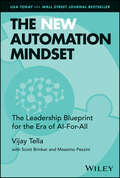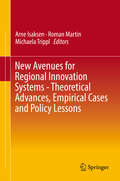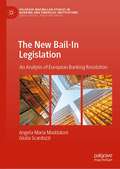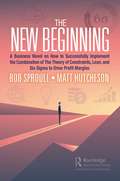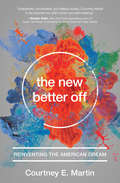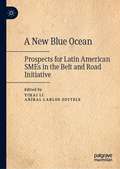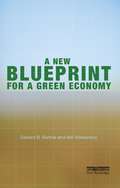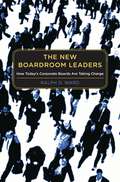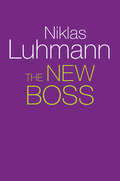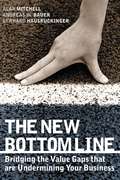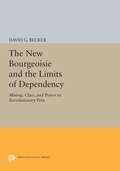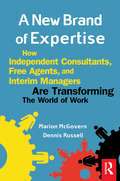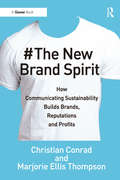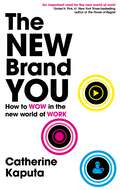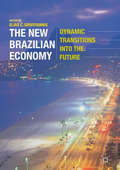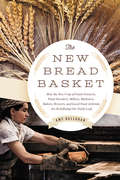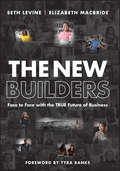- Table View
- List View
The New Automation Mindset: The Leadership Blueprint for the Era of AI-For-All
by Vijay Tella Scott Brinker Massimo PezziniExplore the true potential and impact of business automation Digital transformation of the business landscape is well underway, and businesses are being reshaped faster than ever before. Agility and adaptability are now critical components of these business' survival. But building these traits requires a holistic approach with an unrelenting focus on automation. How does one go about developing that focus? In The New Automation Mindset: The Leadership Blueprint for the Era of AI-for-All, renowned entrepreneur and tech strategists Vijay Tella, Scott Brinker, and Massimo Pezzini deliver a guide to implementing automation in the real world, avoiding jargon and vague bromides in favor of concrete examples of the successful integration of automated technologies and descriptions of the positive results they had on the companies that deployed them. In the book, you'll also find: Hands-on advice for C-suite executives, front-line managers, and everyday employees to implement effective automation frameworks Insightful explorations of the innovation and growth advantages of automation Deep treatments of how automation is about more than just RPA—or Robotic Process Automation—and efficiency An inspiring and practical presentation of one of the most essential topics in business today, The New Automation Mindset will earn a place on the bookshelves of founders, entrepreneurs, managers, shareholders, tech enthusiasts, knowledge workers, and anyone else with an interest in digital transformation and commerce.
The New Automation Mindset: The Leadership Blueprint for the Era of AI-For-All
by Vijay Tella Scott Brinker Massimo PezziniExplore the true potential and impact of business automation Digital transformation of the business landscape is well underway, and businesses are being reshaped faster than ever before. Agility and adaptability are now critical components of these business' survival. But building these traits requires a holistic approach with an unrelenting focus on automation. How does one go about developing that focus? In The New Automation Mindset: The Leadership Blueprint for the Era of AI-for-All, renowned entrepreneur and tech strategists Vijay Tella, Scott Brinker, and Massimo Pezzini deliver a guide to implementing automation in the real world, avoiding jargon and vague bromides in favor of concrete examples of the successful integration of automated technologies and descriptions of the positive results they had on the companies that deployed them. In the book, you'll also find: Hands-on advice for C-suite executives, front-line managers, and everyday employees to implement effective automation frameworks Insightful explorations of the innovation and growth advantages of automation Deep treatments of how automation is about more than just RPA—or Robotic Process Automation—and efficiency An inspiring and practical presentation of one of the most essential topics in business today, The New Automation Mindset will earn a place on the bookshelves of founders, entrepreneurs, managers, shareholders, tech enthusiasts, knowledge workers, and anyone else with an interest in digital transformation and commerce.
New Avenues for Regional Innovation Systems - Theoretical Advances, Empirical Cases and Policy Lessons
by Arne Isaksen Roman Martin Michaela TripplThis book discusses the latest theoretical advances in regional innovation research, presents empirical cases involving the development of regional innovation systems (RISs), and explores regional innovation policy approaches. Grounded in the extensive literature on RISs, it addresses state-of-the-art developments in light of recent theoretical advances in economic geography and related disciplines. Written in honor of Bjørn Asheim's seventieth birthday, the book includes novel and carefully selected chapters prepared by collaborators, colleagues and former PhD-students of one of the founding fathers of RIS research. Further, it makes a significant contribution to the academic debate on regional innovation and growth and offers valuable insights for scholars and policymakers alike.
The New Bail-In Legislation: An Analysis of European Banking Resolution (Palgrave Macmillan Studies in Banking and Financial Institutions)
by Angela Maria Maddaloni Giulia ScardozziFinancial stability is a pillar of well-functioning financial markets. After the last financial crisis, European policymakers harmonised banking regulation and revised the framework of banking resolution. The introduction of the bail-in legislation is a natural experiment to improve the understanding of banking resolution and how it affected the funding strategies of banks. This book assesses whether financial stability has been strengthened by the change in banks’ resolution policy with a focus on the bail-in. The book shows how banks changed their funding strategies, shrank their balance-sheets and relied more on deposits. The book will discuss inter-alia the mis-selling of bonds, which happened during 2012-2013, analysing whether the bond allocation changed after the bail-in launch. It discusses how the bail-in mechanism was deemed credible by equity holders and argues that the European case would have useful implications for third countries. Finally, the book relates this discussion to the possible collateral effects generated by the new resolution policy during and after the COVID-19 crisis, which will be of particular interest to researchers and policymakers in banking and financial institutions.
A New Balance of Payments for the United States, 1790–1919: International Movement of Free and Enslaved People, Funds, Goods and Services (Palgrave Studies in American Economic History)
by Lawrence H. OfficerThis book develops new balance of payments statistics for the United States from 1790 to 1919, before official statistics were kept. Part I of this book justifies construction of a new balance of payments table, and Chapter 1 surveys existing tables from that standpoint. Chapter 2 shows how this book overcomes the limitations of Office of Business Economics and its North-Simon-Goldsmith foundation. Specific features are highlighted, including measurement decisions, improvement of OBE series, development of new series, and derived implications for the structure of the US economy and for the importance of individual sectors that loom large at various times: slave trade, shipping, manufacturing, and travel. The book then generates new time series of the movement of people, the movement of goods, the movement of funds, and the provision of services. Part VI puts the new balance of payments table to use in several ways: aggregates and balances within the table, structure of the US economy, and specific sectors of the economy (slave trade, shipping, manufacturing, travel). Finally, Part VII provides concluding comments.
The New Beginning: A Business Novel on How to Successfully Implement the Combination of The Theory of Constraints, Lean, and Six Sigma to Drive Profit Margins
by Bob Sproull Matt HutchesonThis book is a sequel to the business novel, The Secret to Maximizing Profitability – A Business Novel on How to Successfully Combine the Theory of Constraints, Lean, and Six Sigma to Drive Profit Margins to New Levels. In The New Beginning, Tom Mahanan, Tires for All’s former Director of Finance, who learned how to combine the Theory of Constraints with Lean and Six Sigma, and then applied it to Tires for All, to take his company to levels of profitability they had never experienced before. As a reward for his work, Tom was given a permanent seat on the Board of Directors, as long as he continued his improvement work at the remaining portfolio of companies owned by the Board of Directors. Tom performed extremely well, but one day he receives a life-changing phone call from his former mentor, Bob Nelson, the man who he had worked with at Tires for All to make amazing improvements. Bob asks him to play golf with him and two others, Jeff Johnson, from Toner International, and Pete Hallwell, the CFO at Maximo Health Center Complex. Pete and Tom share a golf cart during the round and begin chatting about the work Tom had done at Tires for All and the other portfolio of companies. Pete, who works for a healthcare complex of hospitals, is so impressed with the results Tom had achieved, that he invites him to lunch the following week. Tom accepts his offer of lunch and ultimately, Tom signs a consulting agreement with Pete. Tom had provided an example from a previous improvement effort where he worked with a hospital in Chicago to improve their Emergency Department time for STEMI-type heart attack patients. In his explanation, Tom presents a variety of improvement tools which includes the integration of the Theory of Constraints, Lean, and Six Sigma. Tom then meets with his current employer and specifically, the Chairman of the Board of Directors, Jonathan Briggs, to let him know that he will be resigning to form his own consulting firm. Jonathan then surprises Tom by offering him a consulting agreement to improve all of their portfolio companies. The remainder of the book is all about teaching companies how to combine the Theory of Constraints, Lean, and Six Sigma to obtain optimal results. In the final two chapters, a new problem surfaces, which is the Corona Virus. Essentially, this book teaches the reader how to successfully combine and implement the Theory of Constraints, Lean, and Six Sigma to produce results that many companies only dream of having. It covers a variety of different company types including manufacturing and healthcare.
The New Beginning: A Business Novel on How to Successfully Implement the Combination of The Theory of Constraints, Lean, and Six Sigma to Drive Profit Margins
by Bob Sproull Matt HutchesonThis book is a sequel to the business novel, The Secret to Maximizing Profitability – A Business Novel on How to Successfully Combine the Theory of Constraints, Lean, and Six Sigma to Drive Profit Margins to New Levels. In The New Beginning, Tom Mahanan, Tires for All’s former Director of Finance, who learned how to combine the Theory of Constraints with Lean and Six Sigma, and then applied it to Tires for All, to take his company to levels of profitability they had never experienced before. As a reward for his work, Tom was given a permanent seat on the Board of Directors, as long as he continued his improvement work at the remaining portfolio of companies owned by the Board of Directors. Tom performed extremely well, but one day he receives a life-changing phone call from his former mentor, Bob Nelson, the man who he had worked with at Tires for All to make amazing improvements. Bob asks him to play golf with him and two others, Jeff Johnson, from Toner International, and Pete Hallwell, the CFO at Maximo Health Center Complex. Pete and Tom share a golf cart during the round and begin chatting about the work Tom had done at Tires for All and the other portfolio of companies. Pete, who works for a healthcare complex of hospitals, is so impressed with the results Tom had achieved, that he invites him to lunch the following week. Tom accepts his offer of lunch and ultimately, Tom signs a consulting agreement with Pete. Tom had provided an example from a previous improvement effort where he worked with a hospital in Chicago to improve their Emergency Department time for STEMI-type heart attack patients. In his explanation, Tom presents a variety of improvement tools which includes the integration of the Theory of Constraints, Lean, and Six Sigma. Tom then meets with his current employer and specifically, the Chairman of the Board of Directors, Jonathan Briggs, to let him know that he will be resigning to form his own consulting firm. Jonathan then surprises Tom by offering him a consulting agreement to improve all of their portfolio companies. The remainder of the book is all about teaching companies how to combine the Theory of Constraints, Lean, and Six Sigma to obtain optimal results. In the final two chapters, a new problem surfaces, which is the Corona Virus. Essentially, this book teaches the reader how to successfully combine and implement the Theory of Constraints, Lean, and Six Sigma to produce results that many companies only dream of having. It covers a variety of different company types including manufacturing and healthcare.
The New Better Off: Reinventing the American Dream
by Courtney E. MartinAre we living the good life-and what defines 'good', anyway? Americans today are constructing a completely different framework for success than their parents' generation, using new metrics that TEDWomen speaker and columnist Courtney Martin has termed collectively the "New Better Off". The New Better Off puts a name to the American phenomenon of rejecting the traditional dream of a 9-to-5 job, home ownership, and a nuclear family structure-illuminating the alternate ways Americans are seeking happiness and success.Including commentary on recent changes in how we view work, customs and community, marriage, rituals, money, living arrangements, and spirituality, The New Better Off uses personal stories and social analysis to explore the trends shaping our country today. Martin covers growing topics such as freelancing, collaborative consumption, communal living, and the breaking down of gender roles. The New Better Off is about the creative choices individuals are making in their vocational and personal lives, but it’s also about the movements, formal and informal, that are coalescing around the New Better Off idea-people who are reinventing the social safety net and figuring out how to truly better their own communities.
A New Blue Ocean: Prospects for Latin American SMEs in the Belt and Road Initiative
by Yihai Li Aníbal Carlos ZotteleThis book explores the achievements and obstacles confronting China and major Latin American countries in developing small- and medium-sized enterprises (SMEs) in the context of new changes in “The Belt and Road” Initiative. In the first three chapters, the Chinese authors elaborate on the relationship between “The Belt and Road” Initiative and globalization, as well as strategies towards forming an increasingly close bond between China and Latin America. The book ends with chapters dedicated to analyzing the BRI conditions and effects on SMEs of Latin-American countries. These country specific chapters will show the specific opportunities and challenges the countries conditions, be they political, geological, etc. may have on the development of SMEs under the BRI. The book will be useful not only to industry leaders looking to better understand how they can potentially benefit from the BRI but also by the general public, as the book will explain what this new era of globalization, and more specifically the BRI, will mean for the world’s industries and society.
A New Blueprint for a Green Economy
by Edward B. Barbier Anil MarkandyaPublished in 1989, Blueprint for a Green Economy presented, for the first time, practical policy measures for 'greening' modern economies and putting them on a path to sustainable development. This new book, written by two of the Blueprint for a Green Economy authors, revisits and updates its main messages by asking, first, what has been achieved in the past twenty years, and second, what more needs to be done to generate a truly 'green economy' in the twenty-first century? Blueprint for a Green Economy had one over-arching theme. Making economies more sustainable requires urgent progress in three key policy areas: valuing the environment, accounting for the environment and incentives for environmental improvement. Today, with the threat of global warming, the decline in major ecosystems and their services, and fears over energy security, achieving these goals is even more vital. The current book first summarizes the main messages from Blueprint for a Green Economy and explains why, given rapid and widespread global environmental degradation, they are still relevant. The book then examines the progress since Blueprint for a Green Economy in implementing policies and other measures to improve environmental valuation, accounting and incentives. Although much has been accomplished, additional advances are still required to green economies successfully. The book highlights the new policies and approaches needed for economic management of today's environmental concerns. Over twenty years later, A New Blueprint for a Green Economy once again emphasizes practical policies for greening modern economies, and explains why such an economic roadmap to a greener future is essential, if modern economies are to develop successfully and sustainably.
A New Blueprint for a Green Economy
by Edward B. Barbier Anil MarkandyaPublished in 1989, Blueprint for a Green Economy presented, for the first time, practical policy measures for 'greening' modern economies and putting them on a path to sustainable development. This new book, written by two of the Blueprint for a Green Economy authors, revisits and updates its main messages by asking, first, what has been achieved in the past twenty years, and second, what more needs to be done to generate a truly 'green economy' in the twenty-first century? Blueprint for a Green Economy had one over-arching theme. Making economies more sustainable requires urgent progress in three key policy areas: valuing the environment, accounting for the environment and incentives for environmental improvement. Today, with the threat of global warming, the decline in major ecosystems and their services, and fears over energy security, achieving these goals is even more vital. The current book first summarizes the main messages from Blueprint for a Green Economy and explains why, given rapid and widespread global environmental degradation, they are still relevant. The book then examines the progress since Blueprint for a Green Economy in implementing policies and other measures to improve environmental valuation, accounting and incentives. Although much has been accomplished, additional advances are still required to green economies successfully. The book highlights the new policies and approaches needed for economic management of today's environmental concerns. Over twenty years later, A New Blueprint for a Green Economy once again emphasizes practical policies for greening modern economies, and explains why such an economic roadmap to a greener future is essential, if modern economies are to develop successfully and sustainably.
The New Boardroom Leaders: How Today's Corporate Boards Are Taking Charge (Non-ser.)
by Ralph D. WardFor generations, the cozy, standard model of boardroom leadership was simple: The CEO was also Chairman of the Board, and directors rubberstamped his initiatives. The 2002 Sarbanes-Oxley Act forced radical change on all U.S. public corporations: The board must now hold sessions without management, key committees have tough new independence rules, and all board members now face an unavoidable legal responsibility to provide truly independent oversight of the corporation. Missteps can put companies and individual directors in serious legal danger. The result is an urgent demand that corporate boards develop their own confident, independent leaders from within. But how? That's something that governance expert Ralph Ward, in The New Boardroom Leaders, explains in detail.Until now, no one has tracked and compiled answers to new, basic governance questions. What should a lead director's job description include? Why is a separate chair not necessarily an independent chair? How do you shape an agenda for meetings of independent directors? How do CEOs and the new board leaders divide their roles? How much power should a separate board leader really have? This book answers these questions and more. Companies are scrambling to create new procedures and roles. But there are few job descriptions for these new boardroom leaders—something this book provides, as well as a wealth of insights and tips. The New Boardroom Leaders offers the first inside look at how board leaders actually do their jobs, based on extensive interviews and research. The emphasis will be on practical advice from real board leaders on what worked in their boardrooms, what didn't, and what they expect in the future. It will become a longtime, worthy guide for board members in the new world brought on by Sarbanes-Oxley and the quest for ever-better, and strictly ethical, corporate performance.
The New Boss
by Niklas LuhmannAny organization, no matter how stolid, may be unsettled by the news that a new boss is about to take over. Talk in the hallways increases, staff worry about their jobs, uncertainty grows. Even when the change has happened, problems emerge when the boss who was hired to manage “from above” has to learn about the organization “from below.” In this book, Niklas Luhmann scrutinizes the relationship and shows how it is stretched to its limit by communication difficulties, demands for self-presentation, and disagreements concerning fundamental values. Many of the tensions crystallize around the question “who has the power?” It isn’t necessarily the boss, provided the employees are well versed in the art of directing their superiors. “Subtervision” is Luhmann’s term for this state of affairs, and tact is the most important means to this end. Yet caution is advised: whoever achieves mastery in subtervision may well become the new boss. This slim and thought-provoking book from one of the most influential sociologists of the twentieth century will be of great interest to anyone seeking to understand the dynamics and machinations of the workplace.
The New Boss
by Niklas LuhmannAny organization, no matter how stolid, may be unsettled by the news that a new boss is about to take over. Talk in the hallways increases, staff worry about their jobs, uncertainty grows. Even when the change has happened, problems emerge when the boss who was hired to manage “from above” has to learn about the organization “from below.” In this book, Niklas Luhmann scrutinizes the relationship and shows how it is stretched to its limit by communication difficulties, demands for self-presentation, and disagreements concerning fundamental values. Many of the tensions crystallize around the question “who has the power?” It isn’t necessarily the boss, provided the employees are well versed in the art of directing their superiors. “Subtervision” is Luhmann’s term for this state of affairs, and tact is the most important means to this end. Yet caution is advised: whoever achieves mastery in subtervision may well become the new boss. This slim and thought-provoking book from one of the most influential sociologists of the twentieth century will be of great interest to anyone seeking to understand the dynamics and machinations of the workplace.
The New Bottom Line: Bridging the Value Gaps that are Undermining Your Business
by Alan Mitchell Andreas W. Bauer Gerhard HausruckingerThis radical, provocative and inspiring book explores a tectonic shift at the very heart of business. A shift that?s making the old bottom line of corporate profitability the servant of a new master: a new ?person-centric? bottom line of personal profitability or value ?in my life?. So what? No bottom line? No more profit? Of course not! Every organization must cover its costs. Every business has to make a profit to survive. The authors of The New Global Line remarkably show that the necessary requirements for doing so are changing, and why this transformation ? containing important elements of both evolution and revolution ? is under way, how it?s undermining the foundations of once-great businesses and brands, and how its throwing up huge new opportunities.
The New Bourgeoisie and the Limits of Dependency: Mining, Class, and Power in Revolutionary Peru
by David G. BeckerThe author clarifies the mutually constructive relationship between transnational and the modernizing Peruvian state, showing how the state maintains this relationship while simultaneously nurturing the new class.Originally published in 1983.The Princeton Legacy Library uses the latest print-on-demand technology to again make available previously out-of-print books from the distinguished backlist of Princeton University Press. These editions preserve the original texts of these important books while presenting them in durable paperback and hardcover editions. The goal of the Princeton Legacy Library is to vastly increase access to the rich scholarly heritage found in the thousands of books published by Princeton University Press since its founding in 1905.
A New Brand of Expertise: How Independent Consultants, Free Agents, And Interim Managers Are Transforming The World Of Work
by Dennis Russell Marion McGovernA New Brand of Expertise uniquely clarifies the dynamics of the red-hot "free agent" workplace and teaches the new skills and employment strategies independent professionals must master to succeed. In today's quick and turbulent markets, companies often need specialized professional talent on an interim basis to solve specific business problems, a major trend creating huge opportunities and an alternative career track for many professionals. A New Brand of Expertise clarifies for independent professionals why companies need interim talent and how to develop a skill set that matches market needs. Readers will learn effective methods for uniquely marketing and branding themselves in order to develop a sustainable and successful free agent career.
A New Brand of Expertise
by Dennis Russell Marion McGovernA New Brand of Expertise uniquely clarifies the dynamics of the red-hot "free agent" workplace and teaches the new skills and employment strategies independent professionals must master to succeed. In today's quick and turbulent markets, companies often need specialized professional talent on an interim basis to solve specific business problems, a major trend creating huge opportunities and an alternative career track for many professionals. A New Brand of Expertise clarifies for independent professionals why companies need interim talent and how to develop a skill set that matches market needs. Readers will learn effective methods for uniquely marketing and branding themselves in order to develop a sustainable and successful free agent career.
The New Brand Spirit: How Communicating Sustainability Builds Brands, Reputations and Profits
by Christian Conrad Marjorie Ellis ThompsonEffective sustainability communication can deliver business value. Get it wrong, however, and the reputational damage will be costly. Stakeholders, and the general public as well as activists, are unforgiving of companies whose products, services, business practices or culture fall short of their socially responsible rhetoric. Based on close to one hundred in-depth interviews with leading experts, Christian Conrad and Marjorie Thompson's The New Brand Spirit helps corporate communications and marketing professionals tackle this conundrum by providing a first-hand view of eight distinct and relevant stakeholder perspectives. Nineteen comprehensive and well-researched best practice cases from sustainability leaders like IBM, Unilever, Marks & Spencer and Puma will inspire all those tasked with communicating sustainability with practical and applicable tools and lessons learned. The result is a book that will enable senior executives, corporate communication professionals and brand managers to decide when, to whom and how to communicate sustainability related messages - and when not to.
The New Brand Spirit: How Communicating Sustainability Builds Brands, Reputations and Profits
by Christian Conrad Marjorie Ellis ThompsonEffective sustainability communication can deliver business value. Get it wrong, however, and the reputational damage will be costly. Stakeholders, and the general public as well as activists, are unforgiving of companies whose products, services, business practices or culture fall short of their socially responsible rhetoric. Based on close to one hundred in-depth interviews with leading experts, Christian Conrad and Marjorie Thompson's The New Brand Spirit helps corporate communications and marketing professionals tackle this conundrum by providing a first-hand view of eight distinct and relevant stakeholder perspectives. Nineteen comprehensive and well-researched best practice cases from sustainability leaders like IBM, Unilever, Marks & Spencer and Puma will inspire all those tasked with communicating sustainability with practical and applicable tools and lessons learned. The result is a book that will enable senior executives, corporate communication professionals and brand managers to decide when, to whom and how to communicate sustainability related messages - and when not to.
The New Brand You: How to Wow in the New World of Work
by Catherine KaputaThe New Brand You is the field guide to standing out and succeeding in the new professional landscape transformed by the pandemic. In the new world of virtual, remote and flexible working, everyone needs to consider carefully their personal brand and power, and many will need to hit the 'reset' button. We are all on camera now - we all need to be producers of our own brand narrative. Like it or not, in a digitally driven, more competitive, more global world of employment, the reality is that you need to consider your personal brand. You have no choice, if you don't brand yourself, other people will. And not in the way you want to be seen. That, or you will simply become invisible, and that's almost never good.The New Brand You uses ten tried and tested strategies from the commercial world of branding and applies them to individual brand creation. Strategies such as defining your positioning, researching your target audience and taking steps to ensure you always stay relevant, are equally applicable to individuals as they are to products and companies. It's not about sticking some slightly skewed version of your name on social media, it's about smart positioning and successful tactics. Featuring high profile success stories and accompanied by an online Personal Brand Finder, an assessment tool that measures psychological preferences and aligns with the ten strategies in the book, this book will help you to target the most relevant strategies for you. It will include examples, exercises and callouts to make it a quick read and easy to action immediately. Getting your personal branding right will give you the edge in the new age of work.
The New Brazilian Cinema
by Lúcia NagibLucia Nagib presents a comprehensive critical survey of Brazilian film production since the mid 1990s, which has become known as the "renaissance of Brazilian cinema". Besides explaining the recent boom, this book elaborates on the new aesthetic tendencies of recent productions, as well as their relationships to earlier traditions of Brazilian cinema. Internationally acclaimed films, such as "Central Station", "Seven Days in September" and "Orpheus", are analysed alongside daringly experimental works, such as "Chronically Unfeasible", "Starry Sky" and "Perfumed Ball". Contributors include Carlos Diegues, Robert Stam, Laura Mulvey and Jose Carlos Avellar.
The New Brazilian Economy: Dynamic Transitions into the Future
by Elias C. GrivoyannisThis edited collection provides a thorough historical, statistical, and institutional description of the current Brazilian economy and the previous economic structure from which it is emerging. The contributions explore the institutional economic and cultural forces shaping the current development of the Brazilian economy and discuss how they will influence future progress. Together, the chapters form a picture of the international implications of Brazil’s emergence as a major world economic power. Topics covered include the growth and shrinkage of industry, the consumption boom and the financial crisis, sustainable financial growth and public debt management, the evolution of antitrust policy and the privatization of state-owned firms, and more. Academics and researchers of BRICS countries and Latin American and Caribbean studies will find these contributions a valuable addition to their research.
The New Bread Basket: How the New Crop of Grain Growers, Plant Breeders, Millers, Maltsters, Bakers, Brewers, and Local Food Activists Are Redefining Our Daily Loaf
by Amy HalloranFor more than 10,000 years, grains have been the staples of Western civilization. The stored energy of grain allowed our ancestors to shift from nomadic hunting and gathering and build settled communities—even great cities. Though most bread now comes from factory bakeries, the symbolism of wheat and bread—amber waves of grain, the staff of life—still carries great meaning. Today, bread and beer are once again building community as a new band of farmers, bakers, millers, and maltsters work to reinvent local grain systems. The New Bread Basket tells their stories and reveals the village that stands behind every loaf and every pint. While eating locally grown crops like heirloom tomatoes has become almost a cliché, grains are late in arriving to local tables, because growing them requires a lot of land and equipment. Milling, malting, and marketing take both tools and cooperation. The New Bread Basket reveals the bones of that cooperation, profiling the seed breeders, agronomists, and grassroots food activists who are collaborating with farmers, millers, bakers, and other local producers. Take Andrea and Christian Stanley, a couple who taught themselves the craft of malting and opened the first malthouse in New England in one hundred years. Outside Ithaca, New York, bread from a farmer-miller-baker partnership has become an emblem in the battle against shale gas fracking. And in the Pacific Northwest, people are shifting grain markets from commodity exports to regional feed, food, and alcohol production. Such pioneering grain projects give consumers an alternative to industrial bread and beer, and return their production to a scale that respects people, local communities, and the health of the environment. Many Americans today avoid gluten and carbohydrates. Yet, our shared history with grains—from the village baker to Wonder Bread—suggests that modern changes in farming and processing could be the real reason that grains have become suspect in popular nutrition. The people profiled in The New Bread Basket are returning to traditional methods like long sourdough fermentations that might address the dietary ills attributed to wheat. Their work and lives make our foundational crops visible, and vital, again.
The New Builders: Face to Face With the True Future of Business
by Seth Levine Elizabeth MacBrideDespite popular belief to the contrary, entrepreneurship in the United States is dying. It has been since before the Great Recession of 2008, and the negative trend in American entrepreneurship has been accelerated by the Covid pandemic. New firms are being started at a slower rate, are employing fewer workers, and are being formed disproportionately in just a few major cities in the U.S. At the same time, large chains are opening more locations. Companies such as Amazon with their "deliver everything and anything" are rapidly displacing Main Street businesses. In The New Builders, we tell the stories of the next generation of entrepreneurs -- and argue for the future of American entrepreneurship. That future lies in surprising places -- and will in particular rely on the success of women, black and brown entrepreneurs. Our country hasn't yet even recognized the identities of the New Builders, let alone developed strategies to support them. Our misunderstanding is driven by a core misperception. Consider a "typical" American entrepreneur. Think about the entrepreneur who appears on TV, the business leader making headlines during the pandemic. Think of the type of businesses she or he is building, the college or business school they attended, the place they grew up. The image you probably conjured is that of a young, white male starting a technology business. He's likely in Silicon Valley. Possibly New York or Boston. He's self-confident, versed in the ins and outs of business funding and has an extensive (Ivy League?) network of peers and mentors eager to help his business thrive, grow and make millions, if not billions. You’d think entrepreneurship is thriving, and helping the United States maintain its economic power. You'd be almost completely wrong. The dominant image of an entrepreneur as a young white man starting a tech business on the coasts isn't correct at all. Today's American entrepreneurs, the people who drive critical parts of our economy, are more likely to be female and non-white. In fact, the number of women-owned businesses has increased 31 times between 1972 and 2018 according to the Kauffman Foundation (in 1972, women-owned businesses accounted for just 4.6% of all firms; in 2018 that figure was 40%). The fastest-growing group of female entrepreneurs are women of color, who are responsible for 64% of new women-owned businesses being created. In a few years, we believe women will make up more than half of the entrepreneurs in America. The age of the average American entrepreneur also belies conventional wisdom: It's 42. The average age of the most successful entrepreneurs -- those in the top .01% in terms of their company's growth in the first five years -- is 45. These are the New Builders. Women, people of color, immigrants and people over 40. We're failing them. And by doing so, we are failing ourselves. In this book, you'll learn: How the definition of business success in America today has grown corporate and around the concepts of growth, size, and consumption. Why and how our collective understanding of "entrepreneurship" has dangerously narrowed. Once a broad term including people starting businesses of all types, entrepreneurship has come to describe only the brash technology founders on the way to becoming big. Who are the fastest growing groups of entrepreneurs? What are they working on? What drives them? The real engine that drove Silicon Valley’s entrepreneurs. The government had a much bigger role than is widely known The extent to which entrepreneurs and small businesses are woven through our history, and the ways we have forgotten women and people of color who owned small businesses in the past. How we're increasingly afraid to fail The role small businesses are playing saving the wilderness, small
